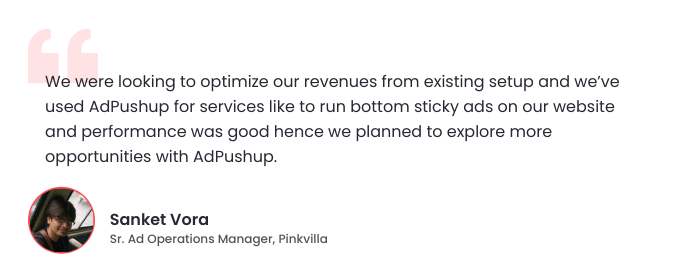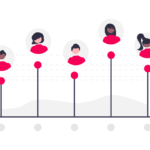Learn all about rCPM (revenue per thousand impressions) for publishers, including its definition, calculation, importance, and how it can help optimize ad revenue. Discover valuable insights and strategies to maximize your earnings as a publisher.
In the digital advertising space, publishers are constantly on the quest to maximize their revenue generation. A crucial metric that helps achieve this goal: rCPM, short for revenue per thousand impressions.
Yes, it’s that important!
But what exactly is it? How does it work? And is it something that is worth paying attention to?
To find the answers, we’re about to dive deep into the intricacies of rCPM. It doesn’t matter if you’re a seasoned publisher who’s been around the block or a newbie just dipping your toes into the publishing world, ultimately what determines your success is your rCPM (revenue per thousand impressions) strategy.
Mastering rCPM can be a game-changer that can transform the way you make decisions, build strategies, and more, which will keep you ahead of the fierce competition.
So, let’s get started.
What is rCPM?
At its core, rCPM is a metric measuring the revenue generated per thousand ad impressions a publisher serves. It provides insights into the monetary value derived from a publisher’s ad inventory.
Calculating the revenue generated for every thousand impressions can help publishers evaluate their ad monetization performance and make informed decisions to enhance their revenue streams. It’s like a performance gauge that helps publishers evaluate how effective their ad monetization strategies are.
Also Read – What is CPM? A Definitive Guide for Publishers in 2023
The Significance of rCPM for Publishers
Basically, it stands for revenue per thousand impressions. It is a metric that measures the publisher’s revenue for every thousand ad impressions served on their platform. Understanding rCPM is important when it comes to optimizing revenue generation. By analyzing and enhancing the factors contributing to rCPM, publishers can maximize their earnings while delivering valuable content to their audience.
Everything matters, from ad fill rates and quality to ad viewability and placement; each aspect plays a pivotal role in determining rCPM.
To unlock the true potential of revenue optimization, publishers must have a solid grasp of rCPM and its various influencing factors.
Differentiating rCPM from CPM
It’s essential to distinguish rCPM from CPM (cost per thousand impressions), as the two metrics serve different purposes. While rCPM represents revenue earned per thousand impressions, CPM focuses on the cost incurred by advertisers to reach a thousand impressions.
Advertisers primarily use CPM to determine the price they are willing to pay for a thousand ad impressions. On the other hand, rCPM is a metric utilized by publishers to assess the revenue generated from those impressions. By understanding this distinction, publishers can effectively optimize their ad inventory and pricing strategies to maximize their revenue potential.

What are the Key Components of rCPM?
To gain a comprehensive understanding of rCPM and its impact on revenue generation, it is crucial to examine the key components that contribute to this metric.
Let’s break them down one by one:
Ad Fill Rate
The ad fill rate refers to the percentage of ad requests that are successfully filled with ads. A higher ad fill rate indicates that a larger proportion of ad inventory is monetized effectively. Publishers strive for a high ad fill rate to maximize revenue potential.
A low ad fill rate may result from factors such as low demand, ad targeting issues, or ineffective ad placements, which can impact revenue generation.
Ad Quality
Ad quality plays a significant role in the success of ad campaigns and, consequently, rCPM. High-quality ads that resonate with the target audience tend to attract more engagement, resulting in increased revenue potential.
Factors contributing to ad quality include compelling ad creatives, relevant messaging, and seamless integration with the publisher’s content. By prioritizing ad quality, publishers can enhance user experience and drive higher revenue through improved ad performance.
Ad Viewability
Ad viewability measures the visibility of ads to users. It indicates the percentage of ad impressions that are viewable by the audience. Higher ad viewability leads to increased opportunities for user engagement and, subsequently, improved revenue generation.
Publishers should focus on optimizing ad placements, ensuring that ads are displayed in prominent positions that are more likely to capture users’ attention and be viewable without the need for excessive scrolling.
Ad Placement
The placement of ads within a publisher’s website or platform significantly impacts rCPM. Strategic ad placement involves identifying optimal positions that provide maximum visibility and engagement opportunities.
Placing ads in prime locations, such as above the fold or alongside high-traffic content, can lead to higher click-through rates and increased revenue. A well-thought-out ad placement strategy ensures that ads are seamlessly integrated into the user experience while generating the desired revenue for publishers.
Also Check – Understanding CPC vs CPM for Ad Publishers
What Factors Affect rCPM?
To effectively optimize rCPM (Revenue per thousand impressions), publishers must consider several factors that influence this metric.
Understanding these factors and their impact on revenue generation is crucial for publishers aiming to maximize their ad monetization strategies.
Let’s explore these factors:
Website Traffic
Website traffic plays a fundamental role in determining rCPM. Publishers with higher levels of organic and targeted traffic tend to have more opportunities for ad impressions, leading to potential revenue growth.
By focusing on increasing website traffic through various strategies, such as search engine optimization (SEO), content marketing, and social media promotion, publishers can expand their reach and potentially improve their rCPM.
Niche or Industry
The niche or industry in which a publisher operates can significantly impact rCPM. Industries with higher advertising demand or those that cater to a premium audience often command higher ad rates, resulting in a potentially higher rCPM.
Publishers should assess the market dynamics, competition, and advertising demand within their niche to strategically position their content and ad inventory to attract premium advertisers.
Ad Formats
The choice of ad formats can influence rCPM. Certain ad formats, such as video ads or interactive rich media ads, tend to yield higher engagement and better performance, resulting in increased revenue potential.
Publishers must experiment with different ad formats, analyze their performance, and determine the ones that deliver the best results in terms of user engagement and revenue generation.
Also Read – What is Ad Format and What Users Prefer?
Target Audience
The characteristics of the target audience, such as demographics, interests, and purchasing power, can impact rCPM.
Advertisers often target specific audiences with tailored ad campaigns, and publishers who can attract valuable audiences may command higher ad rates and, consequently, a higher rCPM.
Seasonality
Seasonal fluctuations can impact rCPM. Some industries experience higher advertising demand during certain times of the year, such as the holiday season or major events.
It is important for publishers to analyze the seasonal patterns in their niche and adjust their strategies accordingly.
By capitalizing on peak advertising periods and adjusting ad inventory and pricing strategies during slower seasons, publishers can optimize their rCPM and maximize revenue potential.
Also Read – Seasonality Trends in Ad Tech Industry
Strategies to Boost rCPM
To maximize revenue potential and optimize rCPM, publishers can implement a range of effective strategies and best practices.
Here are some of them:
Ad Layout Optimization
Optimizing the layout of ads on your website or platform is crucial for improving user experience and maximizing Revenue.
Consider strategic ad placements that are prominent yet non-intrusive, and blend seamlessly with your content.
Experiment with different ad sizes, formats, and positions to find the optimal combination that generates the highest engagement and revenue.
Ad Network Selection
Carefully selecting the right ad network(s) to partner with is essential for maximizing rCPM. Evaluate the reputation, reach, and performance of different ad networks.
Look for networks that offer high-quality ads, competitive rates, and strong advertiser demand within your niche.
Diversifying your ad network partnerships can also help mitigate risks and increase the potential for higher-paying campaigns.
Ad Targeting
Effective ad targeting enables publishers to deliver ads that are relevant and valuable to their audience, increasing the likelihood of engagement and revenue generation.
Leverage advanced targeting options such as demographics, interests, geolocation, and behavior to refine your ad delivery.
By serving ads that align with your audience’s preferences and needs, you can attract advertisers willing to pay a premium for targeted exposure.
Ad Testing
Continuous testing is essential for optimizing rCPM. Conduct A/B testing to compare different ad formats, placements, designs, and call-to-action strategies.
Analyze the performance metrics, such as click-through rates (CTRs) and conversion rates, to identify the variations that yield the best results.
Implement the insights gained from testing to refine your ad strategy and drive higher revenue.
Ad Viewability Improvement
Improving ad viewability is crucial for enhancing rCPM. Ensure that your ads are positioned in visible areas of your website or platform, especially above the fold.
Optimize page loading times to minimise user abandonment before ads have a chance to load.
Consider implementing technologies such as lazy loading or asynchronous ad loading to enhance the viewability of ads and increase revenue potential.
Conclusion
rCPM is a game-changer for publishers in the digital advertising industry.
rCPM takes into account a whole bunch of factors, such as ad fill rate, ad quality, ad viewability, ad placement, website traffic, niche or industry, ad formats, target audience, and even seasonality.
Publishers need to dig into these factors, analyse them, and optimise them to skyrocket their rCPM performance and rake in higher revenue.
To truly level up, publishers have to implement some kickass strategies. We’re talking ad layout optimization, handpicking the perfect ad networks, nailing that laser-focused ad targeting, running some mind-blowing ad tests, and, of course, making sure those ads are highly viewable.
With these power moves, publishers can give their rCPM a serious boost and achieve mind-blowing monetization outcomes.
And guess what? There’s a platform that specializes in helping publishers maximize their rCPM and take their ad revenue to the next level.
At AdPushup, we offer cutting-edge technology and solutions to optimize ad layouts, perform intelligent ad network selection, improve ad targeting, conduct rigorous ad testing, and enhance ad viewability.
By partnering with AdPushup, publishers can unlock the full potential of their rCPM and witness remarkable monetization outcomes.
rCPM is the secret weapon that publishers rely on to gauge their revenue generation capabilities, make those data-driven decisions, and fine-tune their ad monetization strategies in this cutthroat digital advertising landscape.
And with AdPushup, publishers can unleash their true revenue potential and dominate the game.
Frequently Asked Questions on rCPM
The calculation of rCPM is straightforward. It is derived by dividing the total revenue generated from ads by the total number of impressions and then multiplying that figure by 1000.
CPM (cost per thousand impressions) represents the cost incurred by advertisers for a thousand ad impressions, while rCPM represents the revenue earned by publishers for a thousand ad impressions. They serve different purposes in the digital advertising ecosystem.
Several factors influence rCPM, including ad fill rate, ad quality, ad viewability, ad placement, website traffic, niche or industry, ad formats, target audience, and seasonality.
Publishers can employ various strategies to boost their rCPM, such as optimizing ad layout, selecting the right ad networks, implementing effective ad targeting, conducting ad testing, and improving ad viewability.
rCPM is important for publishers as it helps them assess their ad monetization performance, make informed decisions about their ad inventory, and optimize their revenue generation strategies.
Yes, rCPM is a commonly used metric in digital advertising to compare performance across different platforms, campaigns, or time periods, as it provides a standardized measure of revenue per thousand impressions.
Publishers can analyze their rCPM performance by monitoring key metrics such as revenue, impressions, ad fill rate, ad quality, and engagement rates. They can also use analytics tools and platforms to gain insights into their ad monetization performance.
While rCPM is an important metric, publishers should consider other metrics as well, such as click-through rate (CTR), conversion rate, average Revenue per user (ARPU), and overall Revenue. These metrics provide a more holistic view of revenue optimization.
A growth blog for professional bloggers and ad ops professionals.







